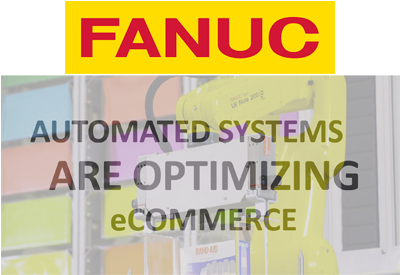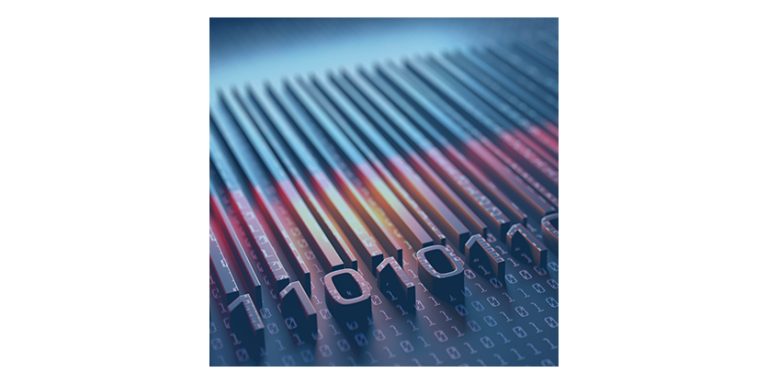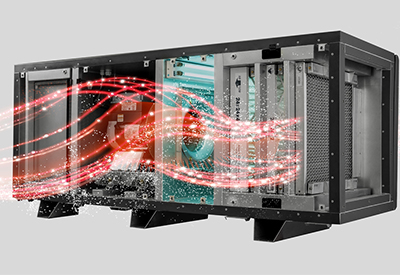Fanuc: Optimize Your Warehouse Footprint with Automation

July 11, 2019
Utilizing Automated Storage and Retrieval Systems Technology to Maximize Space and Resources
With the growth of e-Commerce, comes major changes in global retail and logistics. Because of this, companies are seeking automated warehouse solutions to meet this growth. New automated technologies are providing these companies with the capabilities they need to optimize their use of resources. By minimizing operational space, automated storage and retrieval systems (AS/RS) enable retailers to not only maximize their resources but also ship products faster and more efficiently.
Predicting the Future of Retail
Online retail sales in the U.S. have increased exponentially over the last ten years and show no signs of plateauing. In fact, 69% of Americans have reported purchasing items online as of 2018. To take advantage of this retail market growth and remain appealing to today’s digital-shopper, businesses require a fast, reliable process.
The answer to continuing progress and ensuring a successful future for many growing businesses is automation. Automated Storage and Retrieval Systems are designed to help you:
- Save valuable floor space with vertical integration
- Manage inventory
- Trace product movement
- Automatically operate processes
This technology is providing forward-thinking businesses and warehouse managers everywhere with the opportunity to work smarter, not harder. Implementing AS/RS into warehouses increases order volumes, optimizes space utilization, and ensures reliable and consistent processes. Additionally, these systems are often modular in design and can be tailored to the specific needs of the company.
Tailoring Unique Solutions
Types of AS/RS Technology
There is a range of system options to consider when thinking about implementing AS/RS into your space. Like any investment in new equipment, it’s important to weigh the benefits against your unique needs, vision, and capabilities.
One option is Unit-Load, the solution for heavy-duty orders. This system is designed to handle pallets or cases that weigh thousands of pounds and often operates via cranes that can be fixed or movable, depending on your available space and weight requirements.
The Mini-Load option is best suited for lighter loads that are more dependent upon precision. These fast, accurate robots maneuver via onboard computers that sequence products for rapid retrieval. They can also be utilized to refill product containers if the need for replenishment arises.
Both options allow warehouse managers to quickly respond to customers, better manage inventories, and efficiently utilize space, resources, and employee hours, while sustaining a more cost-effective business model.
Customizing Cutting-Edge Solutions
Automation is realistic for any type of company in any industry, no matter the size. While there are financial and technical aspects to consider, the development of more user-friendly robotics and other advanced technologies makes the switch to automation more accessible, especially for small- or medium-sized businesses.
Picking and packing in large warehouse settings and from high shelves is difficult, inefficient, and not safe for employees. Automated Storage and Retrieval Systems circumvent these challenges by allowing warehouse managers to reallocate their labor hours to areas that require a creative or intuitive touch.
Warehouse space is optimized using a grid system of bins that are condensed and stacked tightly together. With a modular design, this system can expand both in height and width, which is an ideal feature for facilities that have a tough time with real estate.
The system is complemented by rails that run along the edges, providing an avenue for robots to move from product to product across the floor. Robots function via a PC-based process control that interacts directly with a database system as well as the customer’s enterprise system.
This system provides a foundation for future warehouse automation that is scalable, easy to implement, and flexible to adapt to any space.
Next Steps Toward Higher Efficiency
While AS/RS is designed to improve efficiency and speed, it’s important to consider key factors in relation to your current needs and capabilities.
More Space Means More Money
Depending on the solution you choose, any automated elements will represent a significant portion of your investment. That being said, it’s important to note that even a single robot can monitor a vast section of a warehouse. This means that once the robots are accounted for, the more space you can dedicate to storage, the more cost-effective the project will be. Not only that, but vertical space integration provides yet another unique opportunity to maximize valuable horizontal floor space.
User-Friendly Training
Just as with any updated equipment, once implemented, employees that have direct contact with the AS/RS technology will need an appropriate amount of time to become familiar with the new processes and technology. The good news is this technology makes learning seamless with user-friendly menu systems that provide ordering and restocking options.
Automated Storage and Retrieval Systems provide flexibility, accuracy, and speed, allowing retail stores worldwide to remain competitive and able to provide a seamless online shopping experience for their customers.
If you are interested in learning more about how AS/RS technology can significantly improve your business, contact us today to get in touch with one of our systems integrators.






